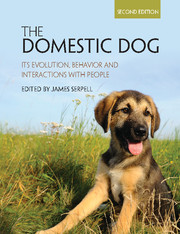Book contents
- Frontmatter
- Dedication
- Contents
- List of contributors
- 1 Introduction
- PART I ORIGINS AND EVOLUTION
- PART II BEHAVIOR, COGNITION AND TRAINING
- 5 Genetics of dog behavior
- 6 Becoming a dog: Early experience and the development of behavior
- 7 Breed and gender differences in dog behavior
- 8 Dog social behavior and communication
- 9 Ethology, ecology and epidemiology of canine aggression
- 10 Social cognition and emotions underlying dog behavior
- 11 The learning dog: A discussion of training methods
- 12 Dogs in today's society: The role of applied animal behavior
- PART III DOG-HUMAN INTERACTIONS
- PART IV LIFE ON THE MARGINS
- Index
- Plate section
- References
11 - The learning dog: A discussion of training methods
from PART II - BEHAVIOR, COGNITION AND TRAINING
Published online by Cambridge University Press: 30 December 2016
- Frontmatter
- Dedication
- Contents
- List of contributors
- 1 Introduction
- PART I ORIGINS AND EVOLUTION
- PART II BEHAVIOR, COGNITION AND TRAINING
- 5 Genetics of dog behavior
- 6 Becoming a dog: Early experience and the development of behavior
- 7 Breed and gender differences in dog behavior
- 8 Dog social behavior and communication
- 9 Ethology, ecology and epidemiology of canine aggression
- 10 Social cognition and emotions underlying dog behavior
- 11 The learning dog: A discussion of training methods
- 12 Dogs in today's society: The role of applied animal behavior
- PART III DOG-HUMAN INTERACTIONS
- PART IV LIFE ON THE MARGINS
- Index
- Plate section
- References
Summary
Introduction
There are currently over 78 million pet dogs in the United States, living in 39% of all US households (American Pet Products Association, 2012), and an undetermined but very large population globally, with highest numbers documented in Brazil, China, Mexico, Japan, Russia and in the European Union (Batson, 2008). Most dogs are kept as companion animals by owners whose training experience and abilities range from naïve to highly skilled. In contrast to guide dogs for the blind, hunting dogs, military, police or other working dogs, pet dogs typically do not have one particular “job” for which a specific, targeted training plan is required. However, through interaction with the physical and social environment, learning is nonetheless important throughout the life of the dog. For example, convincing a young puppy that the yard is the preferred spot for elimination requires learning, as does the middle-aged dog's acceptance of a new baby, or of walking on a leash without pulling. Social learning is continuous and important throughout the life cycle. Whether through planned, deliberate training sessions or more passive associations, the behavior of dogs is largely related to their experiences (see also Serpell et al., Chapter 6). Training should therefore be viewed as a lifelong habit whether or not the dog participates in basic obedience classes.
Canine behavior problems are common (Vacalopoulos & Anderson, 1993) and are the most frequently cited reason for euthanasia, rehoming, or relinquishment of dogs to shelters (Salman et al., 2000). Even owners who forego formal obedience training find it necessary to manage common dog behaviors such as jumping up or excessive barking; after all, any behavior – including aggression at times – that results in a positive outcome for the dog is likely to be repeated. Behavior problems are thus often a consequence of unintentional learning (reinforcement). Furthermore, because many behavior problems in dogs are based in fear or anxiety, the specific method used to modify behavior can also influence its outcome.
Many dog owners seeking help with managing their pets’ behavior do so through friends and neighbors, books, the internet, and television. Unfortunately, the choice of local dog training clubs or individual trainers is often a matter of geographic serendipity, and astonishingly little may be known about the experience, competence and even the ethics of local trainers.
- Type
- Chapter
- Information
- The Domestic DogIts Evolution, Behavior and Interactions with People, pp. 210 - 226Publisher: Cambridge University PressPrint publication year: 2016
References
- 1
- Cited by



